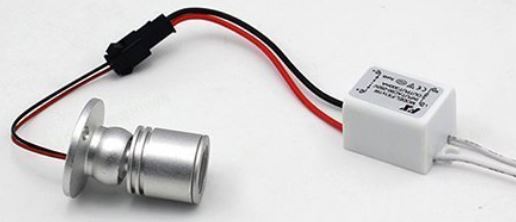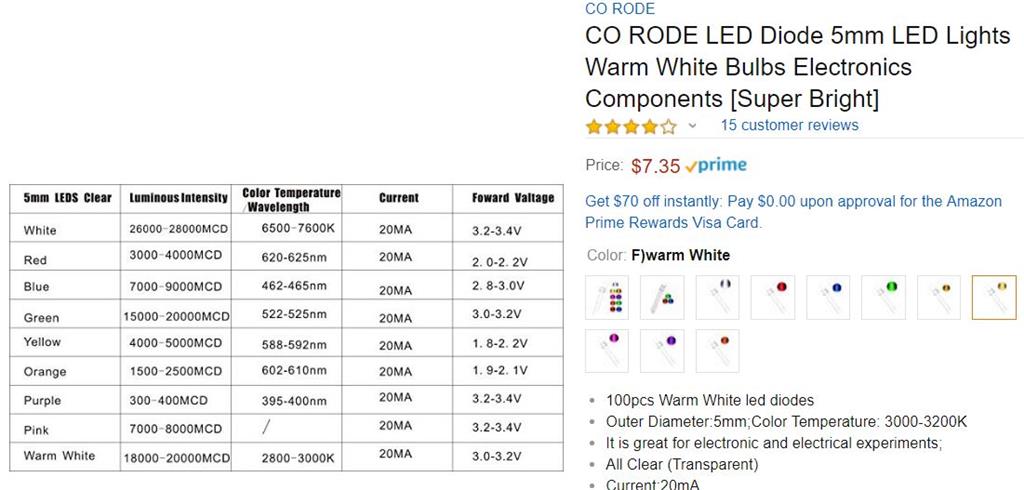rregister
Hi all, I could use some advice from more knowledgeable folks (and more knowledgeable than me’ in this case likely includes: everybody who could possibly be reading this post, ha)
Goal: I would like 2 warm-light spot-lights with brightness control via EZB (presumably via PWM object or the equivalent script command).
Purpose: these lights will be mounted/fixed in position (ie not on a mobile robot) to illuminate a target (~ 5 inch diameter) from a distance of ~ 8 inches. The cable distance from the EZB to the LED will be 4 or 5 feet. The EZB is powered via a fixed 7.4V power supply.
I found these threads Connecting Leds To The Ez-b V4: https://synthiam.com/Community/Questions/8756 Running A Led Of Port D6: https://synthiam.com/Community/Questions/7305 And these are helpful, but to be honest I don’t understand the tradeoffs between what LEDs I choose, the current they use, how bright they are, which pin (or supply?) they draw power from, whether I need multiple LEDs in series (or parallel?) etc.
As a datapoint I did buy these 2 Jorunhe LED spotlights: https://www.amazon.com/gp/product/B01DP874KC
These are 1W LEDs that have a (detachable) AC driver. I hooked them up via an AC power cord and they are certainly bright enough (my primary criteria) and the light is warm in color. These have a substantial housing with a rotational pivot, but that is not a requirement. These have a lens that creates a spotlight but the lens is not a requirement (Edit: I removed the lens and housing, and am happy with how the 'bare' Jorunhe LEDs look). (One solution that I considered is using a opto isolated relay like this: https://www.amazon.com/gp/product/B00TGTX23I -- {tho i’ve never hooked up anything like that, it sounds straightforward} with these Jorunhe LED spotlighs connected via EZB, but ideally I would like to have PWM brightness control. I also considered disconnecting the AC driver from these LEDs and connecting the LEDs directly to the EZB and experimenting to see how bright they can be, but I decided I was likely to either ruin a port on the EZB or burn out the LED. Seeking advice seemed best instead.) I would be happy to use these Jorunhe LEDs if possible, and/or happy to buy a different solution off the shelf (especially if it is under $40) or as parts. I am semi-capable enough to solder an LED to a cable with some heat shrink, but would prefer (is lazy the word I’m looking for? ha) to pay a little extra not to worry about whether I got the short is minus long is plus' thing correct in all cases, haIs anybody willing to help point me in the right direction as to which 'warm light' LEDs (and other parts?) to use and how to connect it to the EZB? Thank a bunch for any advice and ideas.
-Richard Twitch’ R


Richard R,
Correct with the correct voltage and current limiting resister. Yes!
Regarding the OP's Led specs:
What i don't understand is the:
DC provides a variable voltage ? Is it proportional to the AC voltage ?
What is the meaning of 1-3 and 1 Watt.
So P(W) = I(A) x V(V) => 0.3 A x 3 V = 0.9 W
but still confused with a variable interval (3-12)V...
I asked to measure the DC voltage:
Hi ptp and RichardR, thank you for all this information, I really appreciate it.
I have ordered the MOSFETs and I plan to implement that solution using AC power for the Johunre LEDs, sounds great (tho I am worried about the heat sink and overheating, but I will do my best). I will let you know my result and take some photos for anyone else who might benefit.
But I would also be interested in exploring the EZB-powered connection, if you or anybody is willing to spell it out for me?
(I am admittedly slow on the uptake, but) it seems like if I start with an LED with known specs, then it is possible to avoid the AC power, so I searched Amazon for super bright led diode warm and found this: https://www.amazon.com/CO-RODE-Lights-Electronics-Components/dp/B01GDO9XFY

(this price is fine, but I only need maybe 10 anyway (not 100)) I have no idea whether this is appropriate, or whether this will be bright enough (roughly as bright as the 300mA Johunre would be great, but looking at the 20mA current draw, should i infer that these will not be nearly as bright?), so please suggest another if you have an idea for me.Given my setup, my goal would be to figure out what is the most straightforward way to get brightness control and power direct from the EZB. (By straightforward I mean: least chance that a soldering mistake on my part will lead to a prolonged period of head-scratching as to why smoke is coming from my setup, ha.)
>Come to think of it an ESC would work too
I did not know what an ESC was, but i see it is and Electrical Speed Controller (haven’t used one before but am certainly willing) I gather that an H-bridge control is a standard type of ESC (allowing both forward and backward I think, but in this case with the LED I only need forward’ I guess?) (note I took a look at the https://synthiam.com/Support?id=70 HBridge tutorial and I see the 2.5 Amp Motor Controller for $14.99 https://www.ez-robot.com/Shop/AccessoriesDetails.aspx?prevCat=9&productNumber=14 and would be happy to buy that if I need to.)
Looks like I would need 4 ports on the EZB to control 2 LEDs (behaving as left and right motors’ ) independently for brightness? All of the above info is my attempt to understand /regurgitate the alternative approach being suggested by RichardR, please correct me or suggest anything different as seems appropriate.
Thanks again for your advice!
Hi ptp
I measured the voltage across red and black where they emerge from the box
Solution 1
Solution 2
You mentioned before: EZB VIN = 7.4V
Resistor R value calculation:
R(Ohm) = V(V) / I(A) => R = (7.4 V - 3.0V ) / 0.3 A => R = 4.4 V / 0.3 A => R = 14.66 (Ohm)
Resistor R power dissipation:
P(W) = V(V) x I(A) => P = 4.4 V x 0.3 A => P = 1.32 Watts
something like: 15 ohm 2 W resistor will work. https://www.digikey.com/product-detail/en/yageo/FMP200JR-52-15R/15ZCT-ND/2058972
Can someone validate both solutions ?
Hi ptp, This is great, i really appreciate your spelling-out these 2 solutions for me. Solution 2 seems preferable to me as it is simpler and avoids the AC power connection. (I like these Johunre LEDs and now that i think i can control the brightness, i will likely buy some more of them.) I think i understand the ohm's law (that's my level of sophistication, ha) calculation and i ordered the 15ohm resistors (i found some on ebay and think they are the same: https://www.ebay.com/itm/15-Ohm-2w-2-Watt-5-Tolerance-Metal-Oxide-Film-Resistor-10-Pieces/272507518919).
Question for Solution 2: Do i still need to worry about heat measurement and possibly adding a heat sink?
-thanks again so much for helping out!
-Richard 'Twitch' R
LED work great with PWM now, here's some follow up photos
-thanks for the advice ptp!
-Richard 'Twitch' R